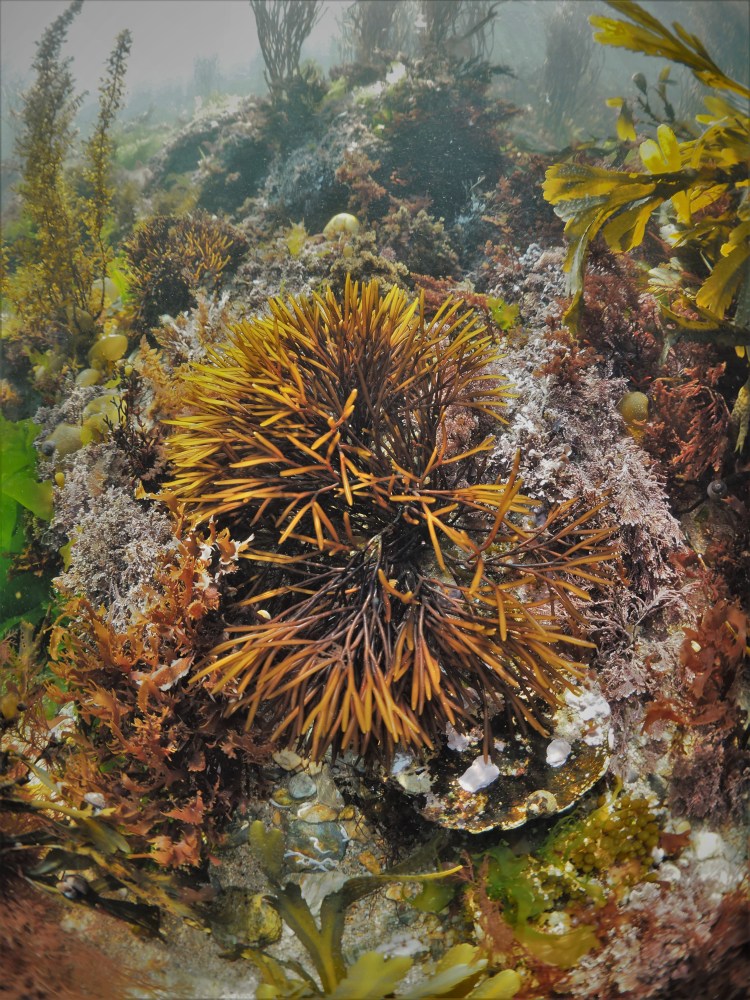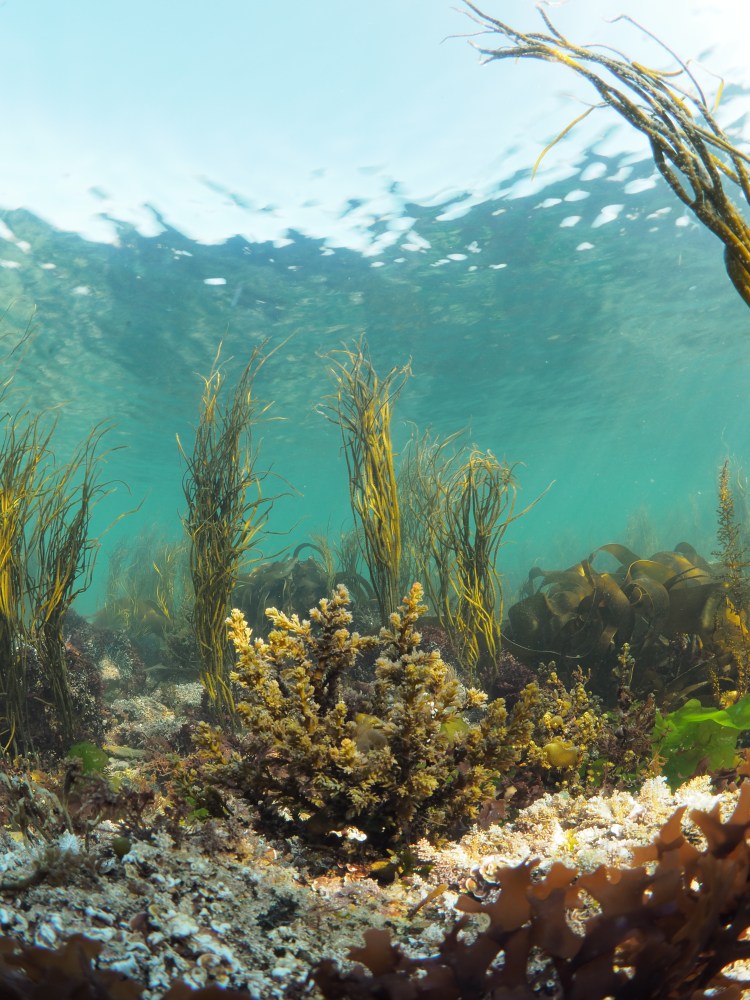 Yesterday I finally took my new camera underwater! I should have gone a bit sooner, but too be fair the water has not been looking very clear (and the viz was still not ideal). The sun was shining and it was great to be back in the water (perhaps 12C, not too cold with a wetsuit). It should be a great experience to shoot with a new, better camera, but it ended up being a bit of a frustrating experience not finding the right settings (I know, first-world problems!). I was stuck in Aperture Priority mode, which was a problem with significant wave action and the need for a fast shutterspeed. Although I took close to 200 photo’s, only a handful were halfway decent. Still, I learned a lot for next time. I took the 8mm fish-eye lens which allows you to get very close to the subject (especially useful for water that is not crystal clear) and still get a wide angle view. Above, a photo of an estuary sponge and seaweeds as well as Snell’s window. Below a badly composed shot of seaweeds, a downward shot of Furcellaria lumbricalis seaweed and Bushy rainbow wrack with Spaghetti weed in the background. All not very sharp and with flat colours, and hopefully standing in stark contrast to the next batch of photo’s!
Yesterday I finally took my new camera underwater! I should have gone a bit sooner, but too be fair the water has not been looking very clear (and the viz was still not ideal). The sun was shining and it was great to be back in the water (perhaps 12C, not too cold with a wetsuit). It should be a great experience to shoot with a new, better camera, but it ended up being a bit of a frustrating experience not finding the right settings (I know, first-world problems!). I was stuck in Aperture Priority mode, which was a problem with significant wave action and the need for a fast shutterspeed. Although I took close to 200 photo’s, only a handful were halfway decent. Still, I learned a lot for next time. I took the 8mm fish-eye lens which allows you to get very close to the subject (especially useful for water that is not crystal clear) and still get a wide angle view. Above, a photo of an estuary sponge and seaweeds as well as Snell’s window. Below a badly composed shot of seaweeds, a downward shot of Furcellaria lumbricalis seaweed and Bushy rainbow wrack with Spaghetti weed in the background. All not very sharp and with flat colours, and hopefully standing in stark contrast to the next batch of photo’s!
Tag Archives: Furcellaria lumbricalis
Falmouth Seaweeds: Mid-March part 2
 More seaweed photos, taken a couple of days after the ones in the previous post, when it was overcast and the water was less clear. The photos are not as good, but there are still a lot of interesting species to see. Below some photos showing the diversity of species next and on top of each other. In the last two months, most species have been growing quite a lot. There are quite large patches of Slender-beaded coral weed Jania rubens. Bushy rainbow wrack Cystoseira tamariscifolia plants are completely overgrown with all kinds of epiphytes, seaweeds, sponges and colonial tunicates, and often have a Nursehound egg case attached.
More seaweed photos, taken a couple of days after the ones in the previous post, when it was overcast and the water was less clear. The photos are not as good, but there are still a lot of interesting species to see. Below some photos showing the diversity of species next and on top of each other. In the last two months, most species have been growing quite a lot. There are quite large patches of Slender-beaded coral weed Jania rubens. Bushy rainbow wrack Cystoseira tamariscifolia plants are completely overgrown with all kinds of epiphytes, seaweeds, sponges and colonial tunicates, and often have a Nursehound egg case attached. 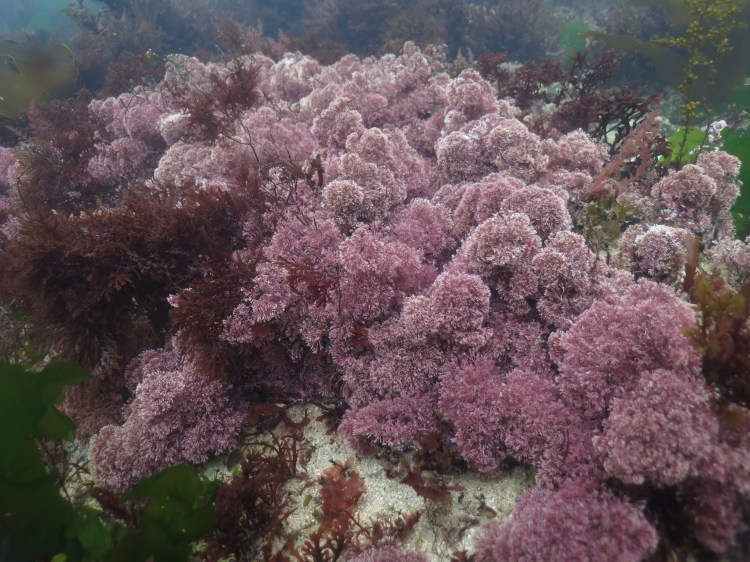
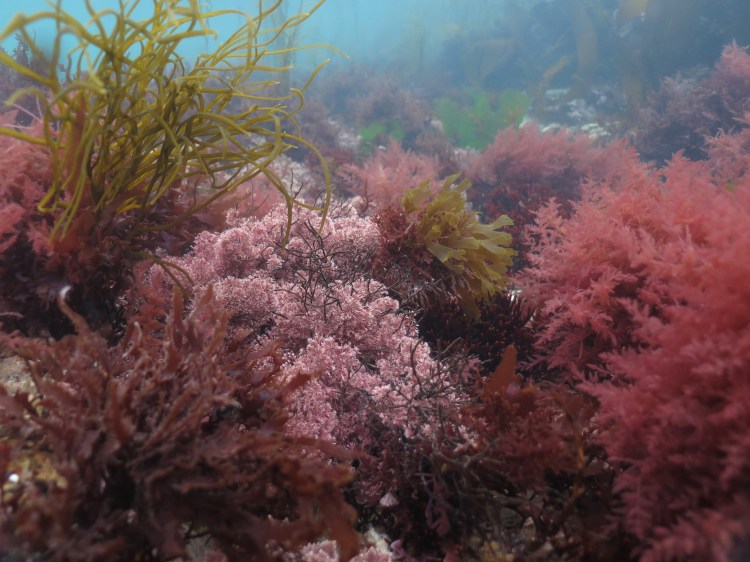



 Next, photos of individual species. First some flat reds: Leafy rose weed Rhodophyllis divaricata, Beautiful fan weed Callophyllis laciniata, Branched hidden ribs Cryptopleura ramosa (probably), the invasive species Devil’s tongue weed Grateloupia turuturu and Under tongue weed Hypoglossum hypoglossoides. After that, two species that look a bit similar: left the reddish Discoid fork weed Polyides rotundus and right Clawed fork weed Furcellaria lumbricalis. The former is one of the most common species (also on the photo above it) but difficult to photograph as it usually sits on the white sand. After that, Juicy whorl weed Chylocladia verticillata. Last, two quite unassuming species: Black scour weed Ahnfeltia plicata and Sea flax weed Stypocaulon scoparium. Identifications made possible using the must-have Seasearch Guide to Seaweeds of Britain and Ireland, David Fenwick’s excellent aphotomarine website (and personal communication) and the good people of the Seaweeds of the NE Atlantic facebook group (any mistakes are my own).
Next, photos of individual species. First some flat reds: Leafy rose weed Rhodophyllis divaricata, Beautiful fan weed Callophyllis laciniata, Branched hidden ribs Cryptopleura ramosa (probably), the invasive species Devil’s tongue weed Grateloupia turuturu and Under tongue weed Hypoglossum hypoglossoides. After that, two species that look a bit similar: left the reddish Discoid fork weed Polyides rotundus and right Clawed fork weed Furcellaria lumbricalis. The former is one of the most common species (also on the photo above it) but difficult to photograph as it usually sits on the white sand. After that, Juicy whorl weed Chylocladia verticillata. Last, two quite unassuming species: Black scour weed Ahnfeltia plicata and Sea flax weed Stypocaulon scoparium. Identifications made possible using the must-have Seasearch Guide to Seaweeds of Britain and Ireland, David Fenwick’s excellent aphotomarine website (and personal communication) and the good people of the Seaweeds of the NE Atlantic facebook group (any mistakes are my own). 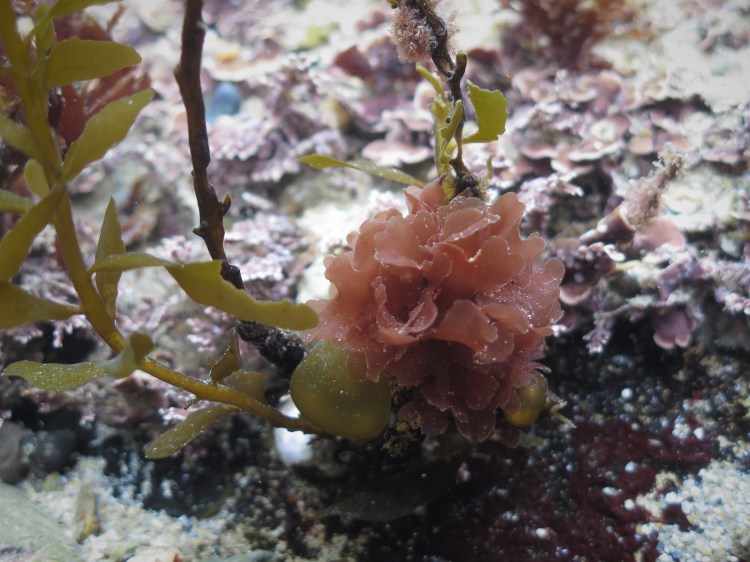



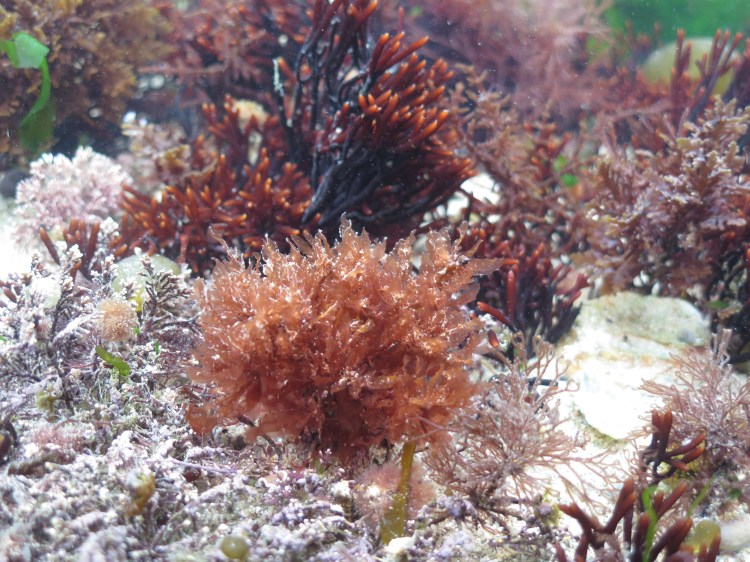


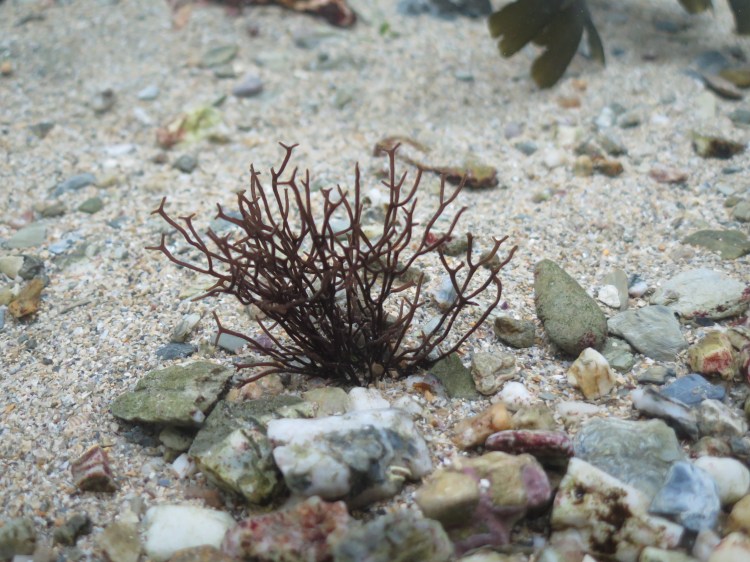

Falmouth Seaweeds: January
 As I noticed that the rock pools have started to look really pretty, I have gone out snorkelling four times the last week to photograph seaweeds. Bitterly cold (around 10°C) but worth it! It is my aim to post photo’s taken at the same spot every month this year, let’s see. The first three days the tide was very low, making it more of a lying on the sand rather than actual snorkelling. The sun was out and my main challenge was to get to grips with overexposure, checking histograms and decreasing image brightness. The other main challenge is to not stir the sand up and create ‘marine snow’. It makes a world of difference to actually stick your head underwater and look through the viewfinder instead of lazily only submerging the camera. For now, I have only cropped and adjusted contrast of jpegs using Picasa, but I have also shot in raw format and hope to get more out of the shots in the near future. With help from the excellent Seasearch Guide to Seaweeds of Britain and Ireland and the Seaweeds of the NE Atlantic facebook page some of the species could be identified.
As I noticed that the rock pools have started to look really pretty, I have gone out snorkelling four times the last week to photograph seaweeds. Bitterly cold (around 10°C) but worth it! It is my aim to post photo’s taken at the same spot every month this year, let’s see. The first three days the tide was very low, making it more of a lying on the sand rather than actual snorkelling. The sun was out and my main challenge was to get to grips with overexposure, checking histograms and decreasing image brightness. The other main challenge is to not stir the sand up and create ‘marine snow’. It makes a world of difference to actually stick your head underwater and look through the viewfinder instead of lazily only submerging the camera. For now, I have only cropped and adjusted contrast of jpegs using Picasa, but I have also shot in raw format and hope to get more out of the shots in the near future. With help from the excellent Seasearch Guide to Seaweeds of Britain and Ireland and the Seaweeds of the NE Atlantic facebook page some of the species could be identified. 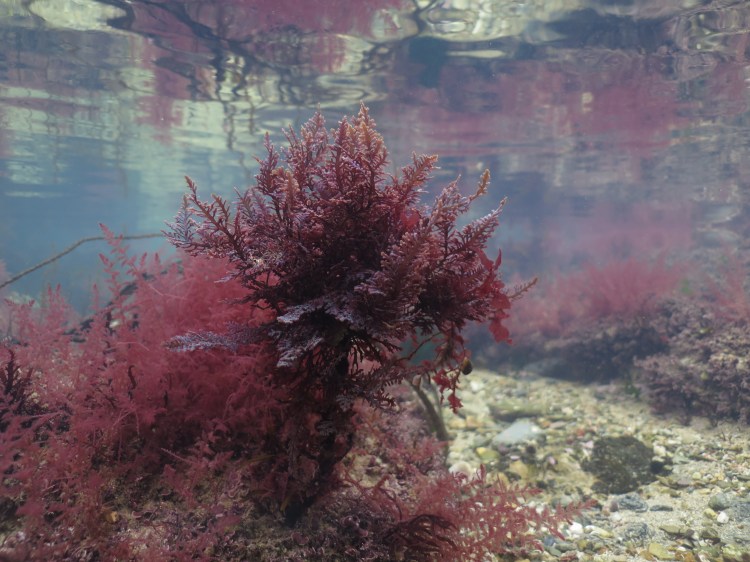
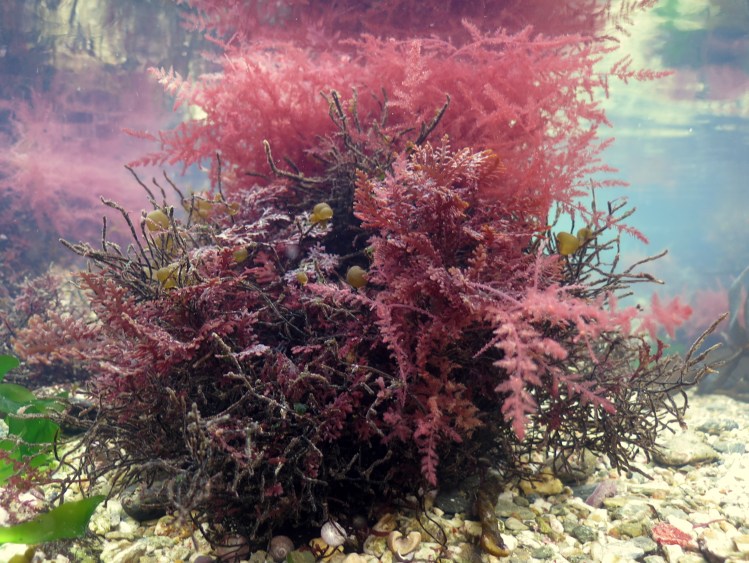
 Above, Osmundea osmunda (probably), which has a very nice blueish (‘glaucus’) tinge (I need to take some close-ups of that next time). In the following photo, a whole tangle of species, mainly Hairy sand weed Cladostephus spongiosus, with Osmundea, Asparagopsis, Bonnemaisonia and Leathesia. Next, another picture of a whole variety of species, I would like to find out what the red epiphyte is. Below some photos of individual species of red seaweeds (mostly not great but it gives an idea of the diversity). First, Leafy rose weed Rhodophyllis divaricata, next Falkenbergia (which is actually not a species but a distinct phase in the life cycle of Harpoonweed Asparagopsis Armata), Berry wart cress Sphaerococcus coronopifolius, Irish moss Chondrus crispus, Beautiful fan weed Callophyllis laciniata, Under tongue weed Hypoglossum hypoglossoides, Chondrus with Falkenbergia and Hypoglossum and Plocamium on top and a small unknown species. You can see that most photos suffer from overexposure (and notice my crude upped contrasts).
Above, Osmundea osmunda (probably), which has a very nice blueish (‘glaucus’) tinge (I need to take some close-ups of that next time). In the following photo, a whole tangle of species, mainly Hairy sand weed Cladostephus spongiosus, with Osmundea, Asparagopsis, Bonnemaisonia and Leathesia. Next, another picture of a whole variety of species, I would like to find out what the red epiphyte is. Below some photos of individual species of red seaweeds (mostly not great but it gives an idea of the diversity). First, Leafy rose weed Rhodophyllis divaricata, next Falkenbergia (which is actually not a species but a distinct phase in the life cycle of Harpoonweed Asparagopsis Armata), Berry wart cress Sphaerococcus coronopifolius, Irish moss Chondrus crispus, Beautiful fan weed Callophyllis laciniata, Under tongue weed Hypoglossum hypoglossoides, Chondrus with Falkenbergia and Hypoglossum and Plocamium on top and a small unknown species. You can see that most photos suffer from overexposure (and notice my crude upped contrasts).
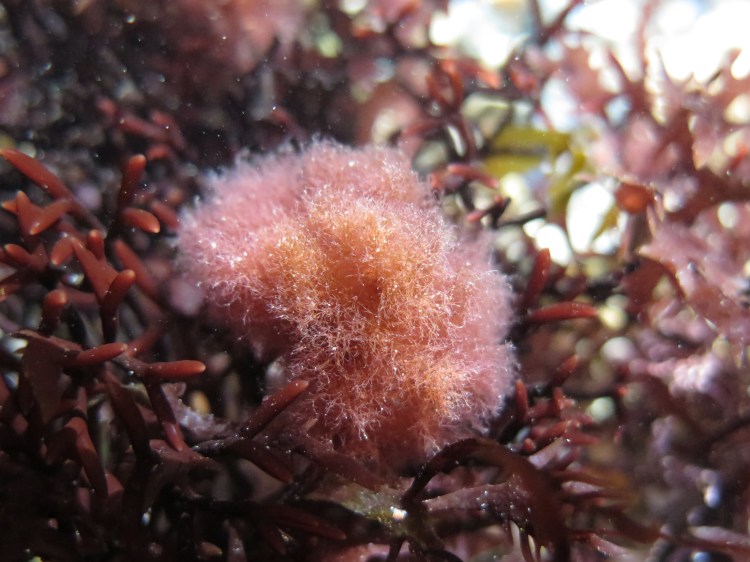




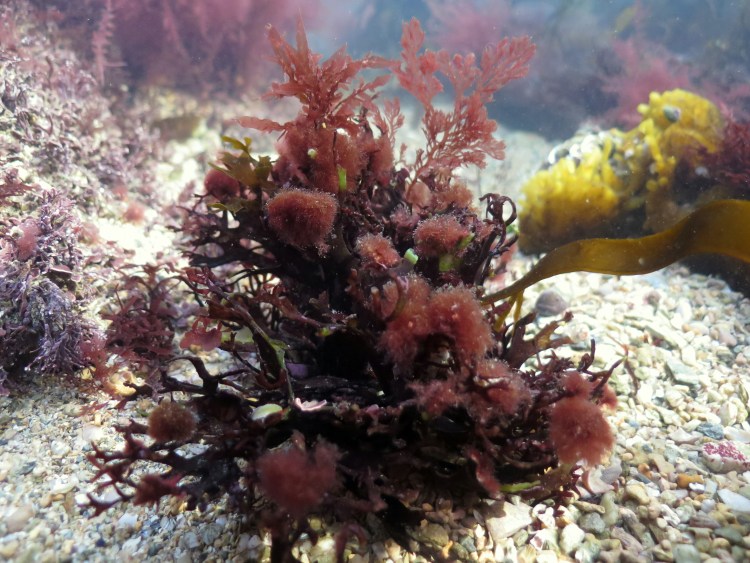
 The last time I went snorkelling, it was overcast and the tide was higher. I tried a bunch of shots a greater distance away to capture more of an overall impression, but with more water between the subject and the lens the shots become ‘milky’. The next shot of a whole variety of red, green and brown species (with Clawed fork weed Furcellaria lumbricalis in the middle) could have been really nice with clearer water, better framing and correct exposure! The next shot shows Cladostephus and Thong weed Himanthalia elongata on top of a rock covered with Red grape weed Gastroclonium ovatum (also on the last photo).
The last time I went snorkelling, it was overcast and the tide was higher. I tried a bunch of shots a greater distance away to capture more of an overall impression, but with more water between the subject and the lens the shots become ‘milky’. The next shot of a whole variety of red, green and brown species (with Clawed fork weed Furcellaria lumbricalis in the middle) could have been really nice with clearer water, better framing and correct exposure! The next shot shows Cladostephus and Thong weed Himanthalia elongata on top of a rock covered with Red grape weed Gastroclonium ovatum (also on the last photo). 

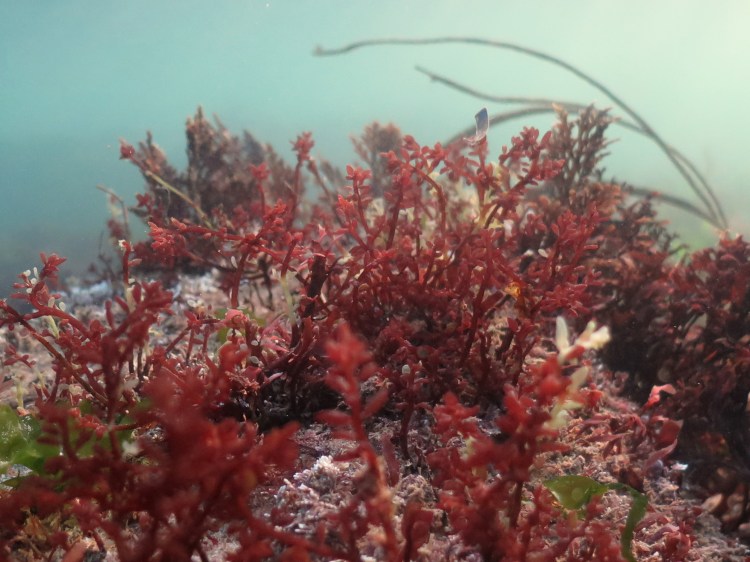
A superlow tide at St. Michael’s Mount
 The lowest tide of the century so far, on a Saturday, with beautiful weather and on a stunning location: what could go wrong? Very little! St. Michael’s Mount, Marazion, Mount’s Bay is one of the most beautiful spots in Cornwall and an excellent site for rock pooling with a mixture of eelgrass beds, rocks and sandy expanses. I felt like a kid in a candy shop: wanting to turn every stone, photograph every seaweed and inspect every gully before the tide would come back in. I needed to collect some more Clawed fork weed Furcellaria lumbricalis for a cool student project. That was abundant so easy to sort. Chock full of Pheasant shells Tricolia pullus. One other amazing thing was that the place was littered with Bull huss Scyliorhinus stellaris (a.k.a. Nursehound, a.k.a. Large-spotted dogfish) mermaids purses. Mount’s bay is an important breeding ground for these sharks. The yolk was easy to spot, but the embryo’s still to small to be seen. There were loads of pretty seaweeds gently waving among the eelgrass in the crystal clear water. I saw a bright green Chameleon prawn swimming about, but the picture I took was a bit underwhelming.
The lowest tide of the century so far, on a Saturday, with beautiful weather and on a stunning location: what could go wrong? Very little! St. Michael’s Mount, Marazion, Mount’s Bay is one of the most beautiful spots in Cornwall and an excellent site for rock pooling with a mixture of eelgrass beds, rocks and sandy expanses. I felt like a kid in a candy shop: wanting to turn every stone, photograph every seaweed and inspect every gully before the tide would come back in. I needed to collect some more Clawed fork weed Furcellaria lumbricalis for a cool student project. That was abundant so easy to sort. Chock full of Pheasant shells Tricolia pullus. One other amazing thing was that the place was littered with Bull huss Scyliorhinus stellaris (a.k.a. Nursehound, a.k.a. Large-spotted dogfish) mermaids purses. Mount’s bay is an important breeding ground for these sharks. The yolk was easy to spot, but the embryo’s still to small to be seen. There were loads of pretty seaweeds gently waving among the eelgrass in the crystal clear water. I saw a bright green Chameleon prawn swimming about, but the picture I took was a bit underwhelming. 
 I had met up with David Fenwick, so could get all species identified on the spot. Very striking was a great amount of small, fuzzy pink seaweed balls: Falkenbergia, the tetrasporophyte stage of the Harpoon weed Asparagopsis armata (it looks so different from the gametophyte stage, see some old posts, that it was long considered a separate species). Also, a picture of Bushy rainbow wrack Cystoseira tamariscifolia, simply because one cannot post too many pictures of Bushy rainbow wrack….
I had met up with David Fenwick, so could get all species identified on the spot. Very striking was a great amount of small, fuzzy pink seaweed balls: Falkenbergia, the tetrasporophyte stage of the Harpoon weed Asparagopsis armata (it looks so different from the gametophyte stage, see some old posts, that it was long considered a separate species). Also, a picture of Bushy rainbow wrack Cystoseira tamariscifolia, simply because one cannot post too many pictures of Bushy rainbow wrack….
 Some invertebrates: the large scale worm Alentia gelatinosa, a Strawberry worm Eupolymnia nebulosa larger still, a tiny hermit crab Anapagurus hyndmanni and the Arctic cowrie Trivia arctica:
Some invertebrates: the large scale worm Alentia gelatinosa, a Strawberry worm Eupolymnia nebulosa larger still, a tiny hermit crab Anapagurus hyndmanni and the Arctic cowrie Trivia arctica:
 The find of the day (the month probably) was a Little cuttlefish Sepiola atlantica. This picture is crap, but David has made some stunning photos back in his lab and they will appear sometime soon on his aphotomarine site I am sure.
The find of the day (the month probably) was a Little cuttlefish Sepiola atlantica. This picture is crap, but David has made some stunning photos back in his lab and they will appear sometime soon on his aphotomarine site I am sure.
Pheasant shell
new lighting
My new 55 watt fluorescent Philips daylight lamps arrived last week. The first picture shows the two standard 10.000 K actinic lamps that come with the Red Sea Max 130D; the second picture shows the two new daylight lamps. I found he light coming from the actinic lamps always looking rather harsh, but the daylight lamps looked awfully yellow. I decided to compromise between photosynthesis and aesthetics and go for one of each type (third picture):
As you can see, the Wireweed and Dudresnays whorled weed are doing very well.
The 10.000 K lamp (top) and the 6500 K lamp. Contrary to my expectation, the temperature dropped using the new lighting: from 25C to 23C, good! I have ‘planted’ some Furcellaria lumbricalis, let’s see what it does:
Yesterday I discovered a big patch of Bushy rainbow wrack Cystoseira tamariscifolia on Castle beach in Falmouth (I noticed that this seaweed grows quite high on the shore at this location). I should have brought a small plant back to test with the new lighting (and lower temperature and salinity) but I reckoned it would be best to wait a bit until I have a chiller as well to get all conditions right. Hmmm, maybe I’ll go back today…

